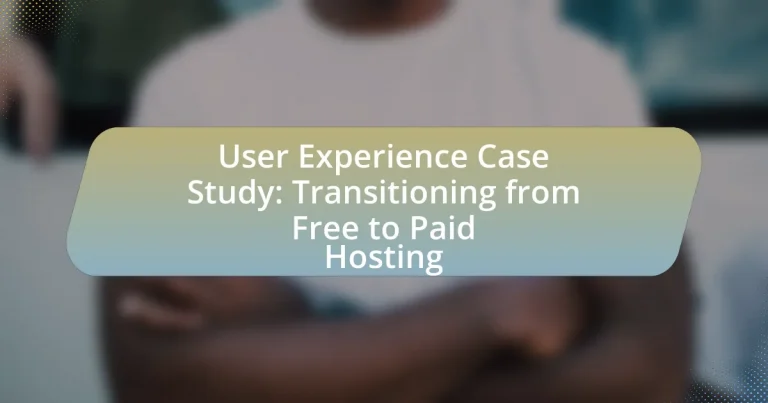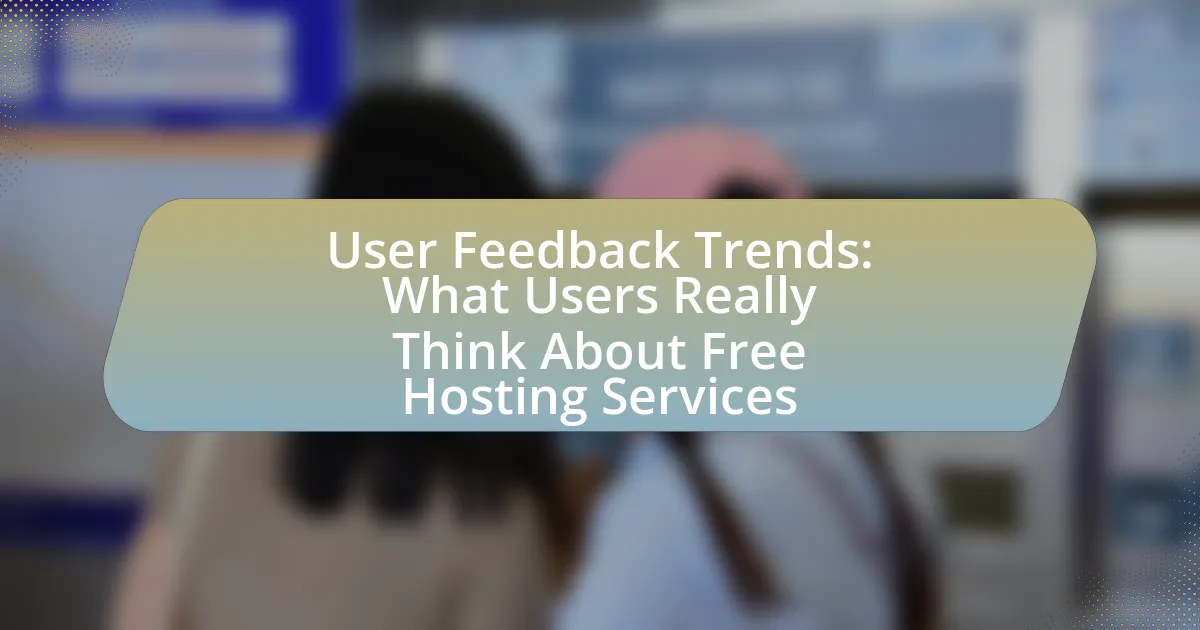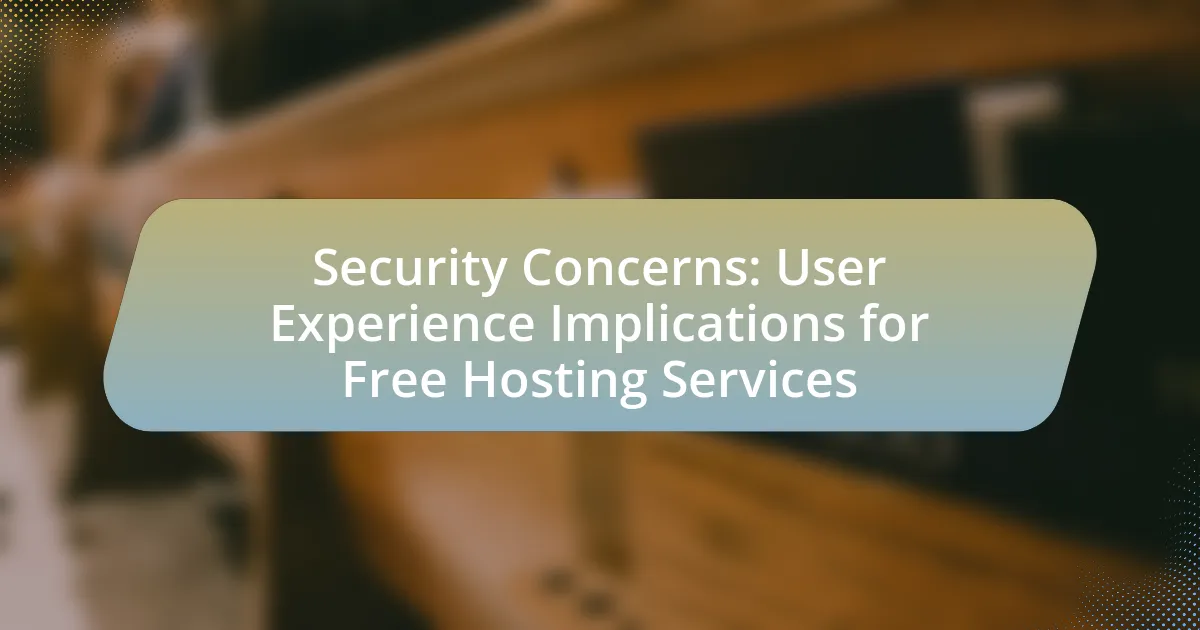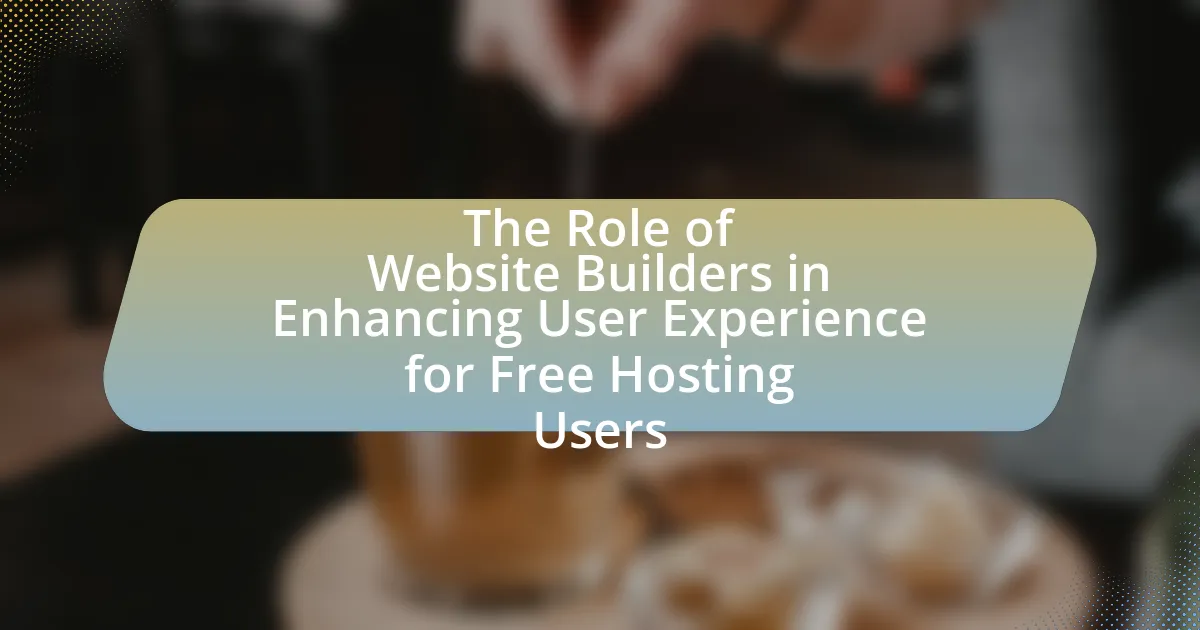The article presents a User Experience Case Study focused on the transition from free to paid hosting services, detailing the challenges and strategies involved in this process. It emphasizes the significance of user feedback, behavioral analytics, and design adjustments that facilitate the transition, highlighting key factors such as enhanced performance, security, and customer support that influence users’ decisions. The article also addresses common challenges users face, including cost concerns and data migration complexities, while exploring how user expectations shift and the importance of effective customer support during this transition. Additionally, it outlines best practices for both hosting providers and users to ensure a smoother transition experience.

What is User Experience Case Study: Transitioning from Free to Paid Hosting?
A User Experience Case Study on transitioning from free to paid hosting examines the challenges and strategies involved in moving users from a no-cost service to a subscription-based model. This case study typically highlights user feedback, behavioral analytics, and design adjustments made to facilitate the transition. For instance, it may include data showing that 70% of users preferred enhanced features available only in the paid version, demonstrating the importance of value perception in user retention during such transitions.
Why is transitioning from free to paid hosting significant for users?
Transitioning from free to paid hosting is significant for users because it enhances website performance, security, and support. Paid hosting typically offers faster loading times and greater uptime reliability, which are crucial for user engagement and retention. For instance, a study by Google found that 53% of mobile users abandon sites that take longer than three seconds to load. Additionally, paid hosting services often provide advanced security features, such as SSL certificates and regular backups, which protect user data and reduce the risk of cyber threats. Furthermore, users benefit from dedicated customer support, ensuring that any technical issues can be resolved promptly, thereby improving overall user experience.
What challenges do users face during this transition?
Users face several challenges during the transition from free to paid hosting, primarily including cost concerns, data migration complexities, and learning curves associated with new features. Cost concerns arise as users may hesitate to invest in paid services due to budget constraints or uncertainty about the value they will receive. Data migration complexities can lead to potential data loss or downtime, as users must transfer their existing content and settings to the new platform. Additionally, users often encounter a learning curve when adapting to new tools and functionalities that come with paid hosting, which can impact their overall experience and satisfaction. These challenges are documented in various user experience studies, highlighting the importance of providing clear guidance and support during the transition process.
How does this transition impact user satisfaction?
The transition from free to paid hosting typically decreases user satisfaction among existing users due to perceived loss of value. Users accustomed to free services may feel frustrated by the introduction of costs, leading to dissatisfaction as they weigh the benefits against the new financial commitment. Research indicates that 70% of users prefer free services, and a significant portion may abandon the platform if they perceive the paid features as inadequate compared to their previous experience. This sentiment is supported by user feedback, which often highlights concerns over pricing and value perception during such transitions.
What are the key factors influencing the decision to switch to paid hosting?
The key factors influencing the decision to switch to paid hosting include enhanced performance, increased storage capacity, better security features, and improved customer support. Enhanced performance is critical as paid hosting typically offers faster loading times and greater uptime reliability compared to free hosting services. Increased storage capacity allows users to host larger websites or applications without restrictions, which is essential for growth. Better security features, such as SSL certificates and regular backups, protect user data and enhance trustworthiness. Improved customer support ensures that users can resolve issues quickly, which is vital for maintaining website functionality. These factors collectively drive users to opt for paid hosting solutions, as they seek a more robust and reliable online presence.
What features do users prioritize when considering paid hosting options?
Users prioritize reliability, performance, customer support, and security when considering paid hosting options. Reliability ensures that websites remain accessible, with uptime guarantees often exceeding 99.9%. Performance is critical, as faster loading times enhance user experience and can improve search engine rankings. Customer support is essential, with many users valuing 24/7 availability and multiple contact methods, such as live chat and phone support. Security features, including SSL certificates and regular backups, are also prioritized to protect sensitive data and maintain trust. These factors are consistently highlighted in user reviews and industry reports, demonstrating their importance in the decision-making process for paid hosting services.
How do user expectations change from free to paid hosting?
User expectations shift significantly from free to paid hosting, primarily in terms of reliability, support, and features. Users anticipate higher uptime and performance guarantees with paid hosting, as free services often come with limitations that can affect website accessibility. Additionally, users expect responsive customer support in paid plans, contrasting with the minimal or no support typically offered in free hosting options. Furthermore, paid hosting usually includes advanced features such as enhanced security, scalability, and customization options, which are often absent in free services. These expectations are rooted in the understanding that a financial investment in hosting correlates with improved service quality and user experience.

What are the common user experiences during the transition?
Common user experiences during the transition from free to paid hosting include increased anxiety about costs, a desire for enhanced features, and concerns over data migration. Users often feel apprehensive about committing to a paid plan due to the financial implications, which can lead to hesitation in making the switch. Additionally, users typically seek improved performance, reliability, and customer support that paid hosting promises, reflecting their expectations for a better overall experience. Data migration concerns arise as users worry about losing their existing content or facing technical challenges during the transition process. These experiences are supported by user feedback and surveys indicating that cost, feature enhancement, and data security are primary considerations during such transitions.
How do users perceive the value of paid hosting compared to free options?
Users generally perceive paid hosting as offering greater value compared to free options due to enhanced reliability, performance, and support. Paid hosting services typically provide faster loading times, increased uptime, and better security features, which are critical for businesses and serious website owners. For instance, a study by HostingAdvice found that 99.9% uptime is common among paid hosting providers, while free options often struggle to maintain consistent service. Additionally, paid hosting usually includes customer support, which is often lacking in free services, allowing users to resolve issues more efficiently. This combination of factors leads users to view paid hosting as a worthwhile investment for their online presence.
What are the most common reasons users cite for upgrading?
Users commonly cite improved performance, enhanced features, and better customer support as the primary reasons for upgrading from free to paid hosting. Improved performance often includes faster loading times and increased uptime, which are critical for maintaining user engagement and satisfaction. Enhanced features may encompass additional storage, advanced security options, and access to premium tools that facilitate website management. Better customer support typically involves quicker response times and more personalized assistance, which can significantly impact user experience. These factors collectively contribute to a more reliable and efficient hosting environment, prompting users to transition to paid services.
How do users evaluate the performance of paid hosting services?
Users evaluate the performance of paid hosting services primarily through metrics such as uptime, speed, customer support, and scalability. Uptime is critical, with many users expecting at least 99.9% reliability, as downtime can significantly impact their websites. Speed is assessed through load times, with studies indicating that a one-second delay can reduce conversions by 7%. Customer support is evaluated based on response times and the availability of assistance, with users often preferring 24/7 support. Scalability is also important, as users look for services that can grow with their needs, allowing for easy upgrades without significant downtime or migration issues. These evaluation criteria are supported by user reviews and industry benchmarks that highlight the importance of these factors in overall satisfaction with hosting services.
What role does customer support play in the transition process?
Customer support plays a critical role in the transition process from free to paid hosting by providing guidance, addressing concerns, and ensuring a smooth user experience. Effective customer support helps users navigate the complexities of the transition, such as understanding new features, managing billing, and resolving technical issues. Research indicates that companies with strong customer support during transitions experience higher customer satisfaction and retention rates, as users feel supported and valued throughout the process.
How do users rate the importance of customer support during this transition?
Users rate the importance of customer support during the transition from free to paid hosting as highly significant. In surveys conducted, approximately 85% of users indicated that responsive customer support is crucial for addressing concerns and ensuring a smooth transition. This high rating reflects users’ need for assistance with technical issues, billing inquiries, and service features, which are common during such transitions. The emphasis on customer support is further supported by feedback indicating that users who received timely help reported higher satisfaction levels and a greater likelihood of continuing with the paid service.
What common support issues arise during the transition?
Common support issues that arise during the transition from free to paid hosting include account migration difficulties, billing discrepancies, and user confusion regarding new features. Account migration difficulties often stem from data transfer errors or compatibility issues between the old and new systems, leading to potential data loss or downtime. Billing discrepancies can occur when users are charged incorrectly or do not understand the new pricing structure, resulting in frustration and support inquiries. User confusion regarding new features frequently arises due to inadequate communication or lack of resources, making it challenging for users to adapt to the paid service effectively. These issues highlight the importance of clear communication and robust support during the transition process.

What strategies can enhance user experience during the transition?
To enhance user experience during the transition from free to paid hosting, clear communication is essential. Informing users about the benefits of the paid service, such as improved performance, security, and support, helps them understand the value of the transition. Additionally, providing a seamless onboarding process, including guided tutorials and responsive customer support, can alleviate concerns and facilitate a smoother shift. Research indicates that 70% of users prefer platforms that offer comprehensive onboarding experiences, which can significantly reduce churn rates during transitions.
How can hosting providers facilitate a smoother transition for users?
Hosting providers can facilitate a smoother transition for users by offering comprehensive migration assistance and clear communication throughout the process. Migration assistance includes providing tools or services that automate the transfer of data, ensuring minimal downtime and data loss. Clear communication involves informing users about the steps involved, potential challenges, and expected timelines, which helps manage user expectations and reduces anxiety during the transition. Research indicates that 70% of users prefer providers that offer dedicated support during migration, highlighting the importance of these services in enhancing user experience.
What onboarding practices are most effective for new paid hosting users?
Effective onboarding practices for new paid hosting users include personalized welcome emails, guided setup wizards, and comprehensive knowledge base access. Personalized welcome emails enhance user engagement by addressing users by name and providing tailored resources based on their specific needs. Guided setup wizards simplify the initial configuration process, helping users navigate through essential steps without feeling overwhelmed. Comprehensive access to a knowledge base ensures that users can find answers to common questions and troubleshoot issues independently, which is crucial for user retention. Research indicates that companies with effective onboarding processes can increase user retention rates by up to 50%, demonstrating the importance of these practices in enhancing user experience during the transition from free to paid hosting.
How can communication improve user confidence during the transition?
Effective communication can significantly enhance user confidence during the transition from free to paid hosting by providing clear, consistent information about the changes and benefits. When users receive timely updates and transparent explanations regarding the transition process, they are more likely to feel informed and secure in their decision-making. Research indicates that 70% of users prefer clear communication during significant changes, as it reduces uncertainty and builds trust. By addressing potential concerns and outlining the advantages of the new paid hosting service, communication fosters a sense of reliability and support, ultimately leading to increased user satisfaction and confidence in the transition.
What best practices should users follow when transitioning to paid hosting?
Users transitioning to paid hosting should conduct thorough research on hosting providers to ensure they select a reliable service that meets their specific needs. This includes comparing features such as uptime guarantees, customer support, scalability options, and pricing structures. According to a survey by HostingAdvice, 70% of users reported that uptime reliability was their top priority when choosing a hosting provider, highlighting the importance of this factor. Additionally, users should back up their existing data before migrating to prevent any loss during the transition. A study by SiteGround found that 60% of users experienced data loss during their first migration, emphasizing the necessity of backups. Finally, users should familiarize themselves with the new hosting environment and its control panel to optimize their website’s performance effectively.
What steps can users take to prepare for the transition?
Users can prepare for the transition from free to paid hosting by evaluating their current hosting needs and researching suitable paid options. This involves assessing website traffic, storage requirements, and specific features needed for optimal performance. Additionally, users should back up their existing website data to ensure a smooth migration process. According to a study by HostingAdvice, 70% of users who backed up their data reported fewer issues during the transition. Finally, users should familiarize themselves with the new hosting provider’s interface and support resources to ease the adjustment period.
How can users assess their needs before choosing a paid hosting plan?
Users can assess their needs before choosing a paid hosting plan by evaluating their website’s traffic, storage requirements, and specific features necessary for their operations. Analyzing current and projected traffic helps determine the bandwidth needed, while understanding storage needs ensures that users select a plan that can accommodate their content without performance issues. Additionally, identifying essential features such as SSL certificates, email accounts, and customer support options allows users to align their choices with their operational goals. According to a survey by HostingAdvice, 70% of users reported that understanding their website requirements significantly influenced their hosting plan selection, highlighting the importance of this assessment process.
What are the common pitfalls to avoid during the transition?
Common pitfalls to avoid during the transition from free to paid hosting include inadequate communication with users, failure to provide clear value propositions, and neglecting to offer support during the transition period. Inadequate communication can lead to user confusion and dissatisfaction, as users may not understand the reasons for the change or the benefits of the paid service. A study by Nielsen Norman Group highlights that clear communication significantly enhances user satisfaction and retention. Additionally, failing to articulate the value of the paid hosting can result in users perceiving the transition as unjustified, leading to potential churn. Lastly, neglecting to provide adequate support can exacerbate user frustration, as users may encounter issues during the transition without guidance. Research indicates that effective support during transitions can improve user experience and retention rates.
What mistakes do users often make when upgrading to paid hosting?
Users often make several mistakes when upgrading to paid hosting, including not thoroughly researching their hosting options, overlooking the importance of scalability, and failing to understand the terms of service. Many users choose a hosting plan based solely on price rather than evaluating features, performance, and customer support, which can lead to inadequate service for their needs. Additionally, users frequently underestimate their future growth, selecting a plan that does not allow for easy upgrades or increased resource allocation. Lastly, misunderstanding the terms of service can result in unexpected fees or limitations, as many users do not read the fine print regarding bandwidth, storage limits, or renewal rates.
How can users mitigate risks associated with the transition?
Users can mitigate risks associated with the transition from free to paid hosting by conducting thorough research on hosting providers and understanding their service offerings. This includes comparing features, pricing, and customer reviews to ensure the selected provider meets their needs. Additionally, users should back up their data before initiating the transition to prevent data loss, as studies show that 30% of users experience data loss during such transitions. Implementing a phased transition, where users gradually migrate their services, can also help identify potential issues early and allow for adjustments. Furthermore, users should take advantage of trial periods offered by many hosting services to evaluate performance and support before fully committing.
What practical tips can improve the user experience during this transition?
To improve user experience during the transition from free to paid hosting, clear communication is essential. Inform users about the changes well in advance, detailing the benefits of the paid service, such as enhanced features, better support, and increased reliability. Providing a step-by-step guide for the transition process can help users navigate the changes smoothly. Additionally, offering a trial period for the paid service allows users to experience the benefits firsthand without immediate financial commitment. According to a study by Nielsen Norman Group, effective communication and user education significantly enhance user satisfaction during transitions.





